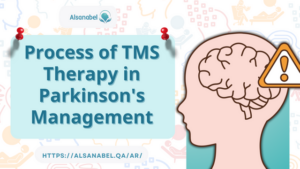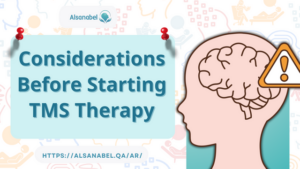The Role of TMS Therapy in Managing Parkinson’s Symptoms 2024
- Category Parkinson's disease
In today’s blog post, we delve into the realm of transcranial magnetic stimulation (TMS) therapy and its potential impact on managing symptoms of Parkinson’s disease. While still not approved for clinical use in this context, scientific findings point to promising benefits for individuals with Parkinson’s. Join us as we explore the role of TMS therapy in enhancing motor and cognitive functions, paving the way for improved quality of life in those living with Parkinson’s.
Process of TMS Therapy in Parkinson’s Management
Transcranial Magnetic Stimulation (TMS) therapy is a non-invasive treatment for Parkinson’s disease that uses magnetic fields to stimulate nerve cells in specific areas of the brain associated with motor control. Here’s how the process typically works:

- Initial Assessment: Patients undergo a thorough evaluation by a neurology or psychiatry specialist to determine their eligibility for TMS. This includes reviewing medical history, conducting physical exams, and possibly imaging studies.
- Target Localization: Once deemed suitable for TMS, healthcare providers identify the specific brain areas related to Parkinson’s symptoms using neuroimaging and clinical observations.
- Treatment Planning: A personalized treatment plan is created, considering factors like the intensity, frequency, and duration of TMS sessions.
- TMS Session: During sessions, patients sit comfortably as a TMS coil is placed on their scalp over the target area. Magnetic pulses stimulate the brain tissue beneath, aiming to alleviate symptoms.
- Monitoring and Adjustment: Providers monitor patient responses during sessions, adjusting stimulation parameters to optimize efficacy and minimize side effects.
- Assessment of Outcomes: After completing TMS, improvements in symptoms, motor function, and quality of life are evaluated to gauge its effectiveness.
- Follow-up Care: Patients may require ongoing maintenance sessions, medication adjustments, or additional therapies to sustain benefits.
While TMS shows promise in managing Parkinson’s, its effectiveness can vary, and more research is needed to fully understand its long-term benefits and optimal use.
Benefits of TMS Therapy for Parkinson’s Patients
TMS treatment shows promise as a non-invasive treatment for Parkinson’s disease (PD), offering several potential benefits:
- Symptom Management: TMS may alleviate motor symptoms like tremors, slowed movement, and rigidity by influencing neural circuits involved in motor control.
- Medication Reduction: It could allow for reduced dosage of PD medications while still controlling symptoms, potentially mitigating medication-related side effects.
- Non-Motor Symptom Improvement: TMS may address non-motor symptoms such as depression, anxiety, and cognitive impairment by targeting specific brain regions implicated in these symptoms.
- Safety and Non-Invasiveness: TMS is non-invasive, carrying minimal risk compared to surgical interventions like deep brain stimulation (DBS).
- Personalized Treatment: Tailored to individual needs, TMS targets specific brain regions and adjusts stimulation parameters based on patient response.
- Adjunctive Therapy: TMS can complement other PD treatments, offering synergistic effects and enhancing overall symptom management.
- Potential Neuroprotective Effects: While more research is needed, TMS may have neuroprotective effects by promoting neuronal plasticity, enhancing dopaminergic function, and reducing neuroinflammation, potentially slowing disease progression.
Overall, TMS for Parkinson’s disease holds promise as a safe and effective treatment, but further research is needed to fully understand its therapeutic potential.
Integrating TMS Therapy into Parkinson’s Care
Integrating Transcranial Magnetic Stimulation (TMS) therapy into Parkinson’s care involves several crucial steps:
- Patient Assessment: Conduct a thorough evaluation of the patient’s medical history, symptoms, and prior treatments to determine suitability for TMS therapy.
- Treatment Planning: Develop a personalized treatment plan outlining the frequency, duration, and intensity of TMS sessions tailored to the patient’s needs.
- Collaborative Care: Involve a multidisciplinary team of healthcare professionals to provide comprehensive Parkinson’s care and ensure coordinated management.
- Monitoring and Adjustment: Regularly monitor patient response to TMS and make necessary adjustments to the treatment plan based on progress and feedback.
- Education and Support: Provide patients and caregivers with education about TMS, including its benefits, risks, and expected outcomes, and offer support throughout the treatment process.
- Long-Term Management: Integrate TMS therapy into the long-term management of Parkinson’s disease, with regular follow-up appointments and ongoing assessments to monitor progress and adjust treatment as needed.
- Research and Innovation: Stay updated on the latest research and advancements in TMS for Parkinson’s disease to incorporate evidence-based practices into clinical care and enhance treatment outcomes.
By following these steps and implementing TMS as part of a comprehensive and coordinated approach to Parkinson’s care, healthcare providers can optimize treatment outcomes and improve patients’ quality of life.
Results of TMS Therapy in Parkinson’s Management
The results of this therapy in Parkinson’s management can vary depending on several factors, including the severity of symptoms, the duration of treatment, and individual patient response. However, research and clinical studies have shown promising outcomes and potential benefits of TMS treatment for Parkinson’s disease management:
- Symptom Improvement: TMS has been reported to improve motor symptoms such as bradykinesia (slowness of movement), rigidity, and tremors in some patients with Parkinson’s disease. By modulating neuronal activity in specific brain regions, TMS may help alleviate motor dysfunction associated with Parkinson’s.
- Quality of Life Enhancement: TMS may contribute to enhancing the quality of life for individuals living with Parkinson’s disease. By targeting brain circuits implicated in motor and non-motor symptoms, TMS has the potential to improve functional abilities, mood, and overall well-being in patients.
- Reduction of Medication Side Effects: In some cases, TMS has been associated with a reduction in medication dosage or side effects commonly experienced with Parkinson’s medications. This may offer patients a more tolerable treatment option and alleviate the burden of medication-related adverse effects.
- Long-Term Effects: While further research is needed to fully understand the long-term effects of TMS in Parkinson’s management, preliminary studies suggest that the benefits of TMS may persist beyond the treatment period. Continued follow-up and maintenance sessions may be necessary to sustain improvements over time.
- Personalized Treatment Approach: TMS can be tailored to the individual needs and preferences of patients with Parkinson’s disease. By adjusting the stimulation parameters and targeting specific brain regions, clinicians can optimize treatment outcomes and address the unique challenges faced by each patient.
Overall, while TMS therapy holds promise as a non-invasive and potentially effective treatment modality for Parkinson’s disease, further research and larger clinical trials are needed to establish its efficacy, safety, and long-term benefits in Parkinson’s management. Collaboration between researchers, clinicians, and patients is essential to advance our understanding of TMS and its role in improving outcomes for individuals living with Parkinson’s disease.
Considerations Before Starting TMS Therapy
Before initiating Transcranial Magnetic Stimulation for Parkinson’s patients, several considerations ensure safe and effective treatment:

- Diagnosis and Severity: Confirm Parkinson’s diagnosis and assess symptom severity through comprehensive evaluations by specialists to determine TMS eligibility and establish baseline symptoms.
- Medical History and Contraindications: Review patient medical history to identify contraindications like seizures, brain injury, or metallic implants, which may deem the patient unsuitable for TMS therapy.
- Medication Management: Optimize medication regimens and ensure stability before starting TMS. Adjustments may be necessary during therapy to complement existing medications.
- Treatment Plan and Expectations: Discuss treatment goals, expectations, benefits, potential side effects, and limitations with patients. Develop a personalized treatment plan based on individual needs.
- Duration and Frequency of Sessions: Determine session duration and frequency based on clinical status, treatment response, and available evidence. Typically, multiple sessions over weeks or months are involved.
- Monitoring and Follow-Up: Regularly monitor treatment response, evaluate symptom improvements, and address any concerns or adverse effects. Close collaboration between patients, caregivers, and healthcare providers is crucial.
By considering these factors, healthcare providers can enhance the safety, efficacy, and success of TMS therapy for Parkinson’s patients, ensuring optimal outcomes and patient satisfaction.
Thank you for taking the time to read about the important role of TMS therapy in managing Parkinson’s symptoms. If you or a loved one are affected by Parkinson’s, I hope this information has been helpful in understanding the potential benefits of this treatment option. As always, it’s crucial to consult with a healthcare professional to determine the best course of action for your specific situation. Please feel free to share your thoughts and experiences with TMS in the comments below.









